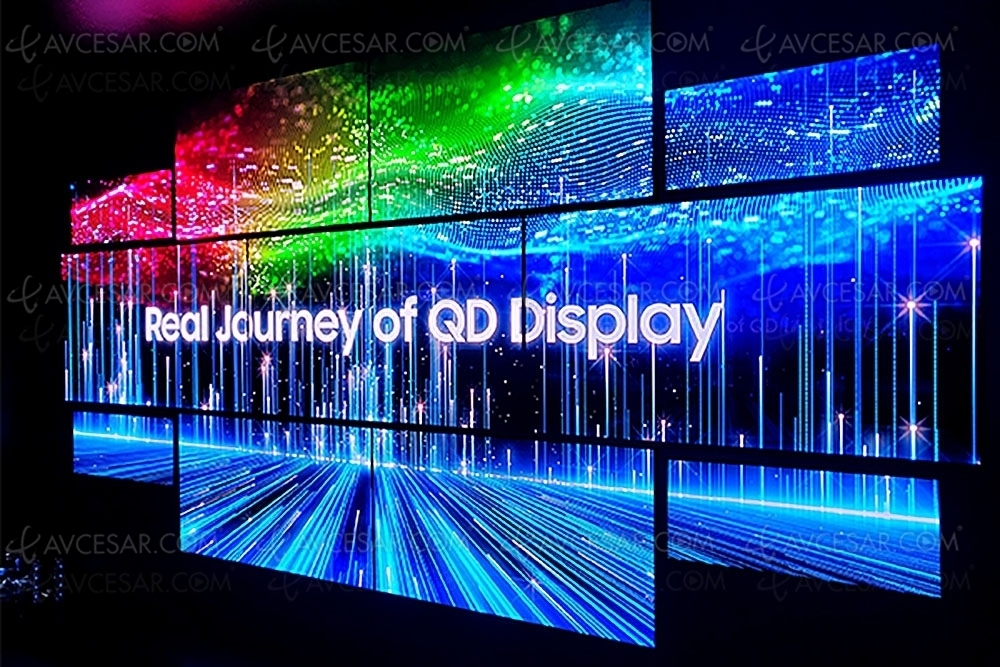Picture
Samsung Display QD OLED, more efficient and less expensive panel in development
30.05.2022 • 10h51
Present in the Samsung S95B and Sony A95K TV series, Samsung Display's QD Oled technology could evolve rapidly for, on the one hand, significantly improved performance, and on the other hand, a lower cost.
Samsung Display, the display manufacturer of the Samsung group, is working hard to improve its QD OLED technology. Korean online daily The Elec first reported the words of Mr. Kwon Jang-hyuk, a professor at the private Kyung Hee University, which has a campus in Seoul and another in Suwon, the historic city of Samsung. . Samsung Display QD Oled new generation in development It was on the occasion of the SID 2022 Review Symposium event held in Seoul on May 18, and which followed Display Week 2022 in early May in San José, California, that Professor Kwon Jang -hyuk spoke about Samsung Display's R&D axes for QD Oled technology.  He notably mentioned the case of blue organic emitters at the base of the QD Oled process. The blue organic diodes directly ensure the blue color of the RGB signal but also serve to excite the Quantum Dots nanocrystals which ensure the conversion of the blue color into red and green colors (see illustration above). Today, the blue emitters present in QD Oled panels are fluorescent in nature, arranged in three layers. Why three layers and not just one? These are necessary in view of the low efficiency of the emitters arranged in triple layer, only 25% of the light generated passes through the panel. Blue emitters phosphorescent and no longer fluorescent Samsung Display's idea is therefore to replace these fluorescent emitters (the light emitted is linked to the presence of an electric current) by phosphorescent specimens (the light emitted persists even without the presence of electric current) whose luminous efficiency at through the panel would be close to 100%. Not to mention that the phosphorescent emitters also guarantee much better durability. In the end, the higher yield would reduce the number of substrates containing the blue emitters, from three to only one according to Professor Kwon Jang-hyuk. Of course, this development would greatly simplify the production of the panels by reducing their cost, in addition to having a positive impact on the overall yield of the manufacturing lines. In development for a while, for more than a year according to various sources, the first visible results are expected in 2022. With probable integration from the next generation of QD Oled panels, i.e. 2023, in the event of positive R&D results.
He notably mentioned the case of blue organic emitters at the base of the QD Oled process. The blue organic diodes directly ensure the blue color of the RGB signal but also serve to excite the Quantum Dots nanocrystals which ensure the conversion of the blue color into red and green colors (see illustration above). Today, the blue emitters present in QD Oled panels are fluorescent in nature, arranged in three layers. Why three layers and not just one? These are necessary in view of the low efficiency of the emitters arranged in triple layer, only 25% of the light generated passes through the panel. Blue emitters phosphorescent and no longer fluorescent Samsung Display's idea is therefore to replace these fluorescent emitters (the light emitted is linked to the presence of an electric current) by phosphorescent specimens (the light emitted persists even without the presence of electric current) whose luminous efficiency at through the panel would be close to 100%. Not to mention that the phosphorescent emitters also guarantee much better durability. In the end, the higher yield would reduce the number of substrates containing the blue emitters, from three to only one according to Professor Kwon Jang-hyuk. Of course, this development would greatly simplify the production of the panels by reducing their cost, in addition to having a positive impact on the overall yield of the manufacturing lines. In development for a while, for more than a year according to various sources, the first visible results are expected in 2022. With probable integration from the next generation of QD Oled panels, i.e. 2023, in the event of positive R&D results.
